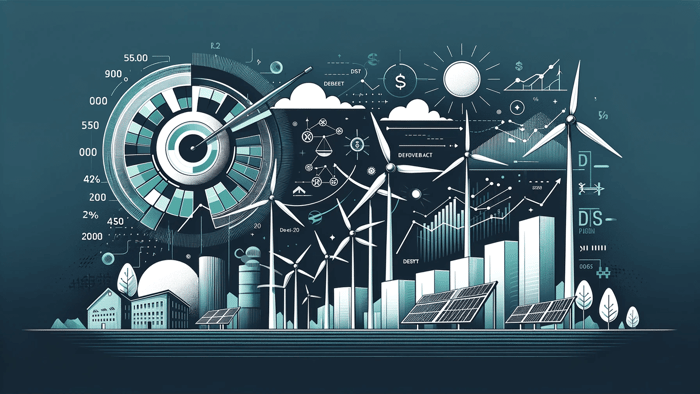CFADS stands for Cash Flow Available for Debt Service. It is a financial metric that calculates the amount of cash generated by a business or investment after deducting all operating expenses, taxes, and capital expenditures. CFADS is often used by lenders to assess a borrower's ability to service debt payments. It is also used in project finance to determine whether a project generates enough cash flow to repay its debt obligations. In essence, CFADS provides a measure of a project's ability to generate enough cash to cover its debt obligations.
CFADS in a project finance-related context
CFADS is an important metric in project finance because it helps lenders evaluate a project's ability to generate sufficient cash to repay its debt obligations. To calculate the CFADS of a solar park or wind farm, the total revenue generated by the project is first calculated by taking the total electricity produced by the solar park or wind farm and multiplying it by the contract price for that electricity.
From this total revenue, all operating expenses, such as maintenance and insurance costs, taxes, and capital expenditures, such as the purchase of new equipment or repairs, are deducted to arrive at the CFADS.
This metric is particularly important in renewable energy projects because they typically require significant upfront capital expenditures and have relatively low operating costs. As a result, lenders use CFADS to evaluate the long-term viability of the project and its ability to generate sufficient cash to repay the debt used to finance its construction.
CFADS determines the maximum amount of debt a project can take on
CFADS is used to determine the amount of debt that can be raised to finance a project. The Debt Service Coverage Ratio (DSCR) is another important metric that is used to evaluate the financial viability of a project by measuring the amount of cash flow available to cover debt service payments.
When determining the amount of debt that can be raised for a project, lenders use a target DSCR, which is the minimum level of cash flow that the project must generate in order to cover debt service payments. The target DSCR is typically set based on the perceived riskiness of the project, with higher-risk projects requiring a higher target DSCR.
To calculate the maximum allowable debt service payments in a given period, the CFADS is divided by the target DSCR. For example, if the CFADS for a project is $10 million per year and the target DSCR is 1.2x, the maximum allowable annual debt service payments would be $8.33 million ($10 million / 1.2).
Debt Sculpting in Project Finance using CFADS
When sculpting a debt profile to match a target DSCR, project finance teams will use CFADS to determine the amount and timing of debt payments required to meet the target DSCR. The process of sculpting a debt profile involves structuring the debt payments to match the expected cash flow available for debt service over the life of the project.
To determine a sculpted debt repayment profile considering a target Debt Service Coverage Ratio (DSCR) of 1.30x, the following steps can be taken:
1. Calculate the Cash Flow Available for Debt Service (CFADS) for each year of the project based on the project finance model. CFADS represents the cash generated by the project that is available to service debt obligations, after taking into account all operating expenses, taxes, and other required payments.
2. Determine the annual debt service for the project based on the financing terms (e.g., interest rate, tenor, payment frequency, etc.). This represents the total amount of principal and interest that needs to be paid each year to service the debt.
3. Calculate the DSCR for each year by dividing the CFADS by the annual debt service. The DSCR represents the project's ability to generate enough cash flow to meet its debt service obligations.
4. Identify the years in which the DSCR falls below the target DSCR of 1.30x. These are the years when the project is at risk of not being able to meet its debt service obligations.
5. In order to sculpt the debt repayment profile, allocate additional principal payments in the years where the DSCR is above the target level, which will reduce the outstanding principal balance of the loan. This will help to reduce the debt service obligation in the future years.
6. The additional principal payments should be calculated such that the DSCR is maintained above the target level in the years where the payments are being made. This can be done by adjusting the size and timing of the additional principal payments.
7. Continue to adjust the debt repayment profile until the DSCR is maintained above the target level in all years of the project.
Overall, a sculpted debt repayment profile helps to ensure that debt service obligations are manageable throughout the life of the project and that the project is able to meet its financial commitments. By adjusting the repayment profile based on the CFADS and the target DSCR, lenders can mitigate the risk of default and ensure that the project is successful over the long term.
Enhance the decision-making process of your organization with a comprehensive financial model dashboard.

If you're looking to invest in renewable energy, you need a comprehensive financial model dashboard that summarizes all the key investment metrics relevant to your decision-making process.
This financial model dashboard for renewable energy investments is designed to help you make informed investment decisions with ease. It includes a detailed breakdown of the project's capital structure, allowing you to understand the financing mix of the project and the risks associated with each layer of the capital stack.
The dashboard also considers critical investment metrics such as IRR and NPV on both a levered and unlevered basis, giving you a complete picture of the project's profitability.
In addition to these essential investment ratios and multiples, the dashboard details the payback periods, CFADS/EV, Revenue/EV, EV/MWp, and EV/MWh. These metrics are crucial in evaluating the financial viability of the project and determining its potential for generating returns over the long term.
The dashboard also features eye-catching charts that provide a visual representation of the project's cash flow generation over its entire asset lifetime. This feature will give you valuable insights into the project's cash flow patterns and help you make informed investment decisions.
With all these critical investment metrics and data points in one place, this financial model dashboard is the ultimate tool for renewable energy investment decision-makers.
How to build a project finance model from scratch?
Do you want to learn how to build a project finance model from scratch? Then check out the Advanced Renewable Energy Financial Modeling course.





